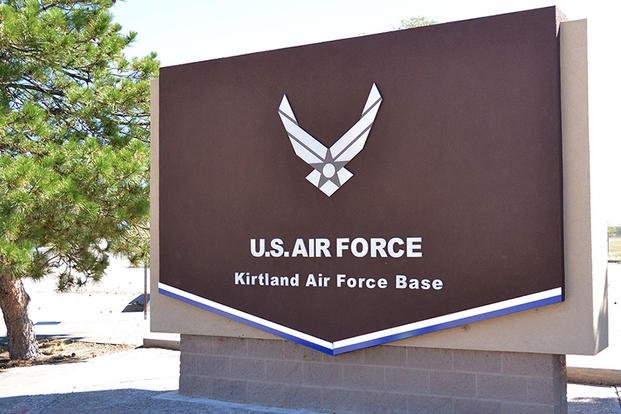
Roughly a 20-minute drive on Kirtland Air Force Base leads to a small, two-story storage unit tucked within the mountains. It’s the first-ever aerial gunnery live-fire training facility, overseen by the 58th Special Operation Wing.
Developed in collaboration with BeaverFit USA, Gulfstream Steel & Supply and Dragonfly Energy, the $615,000 solar-powered gunnery is a full replica of aircraft electrical systems, enabling comprehensive live-fire weapons training.
The gunnery is part of a building block plan to get airmen into helicopters with as much training as possible, said Master Sgt. Garrett Clark.
“This training is all in preparation to get in the helicopter and do it,” Clark said. “Students have a ground and air phase. When you’re in a helicopter, you have a bunch of people talking to you, you’re battling the wind and you have to fire the weapon so this is not as much of a sensation overload.”
Having trainees practice at the gunnery instead of in the sky saves the base an average of $2 million annually and reduces failure rates of trainees by 10 to 20%, Clark said.
He said 20 to 30 trainees graduate each year, and two members go through the training at a time.
Aerospace and defense company Lockheed Martin owns the Sikorsky UH-60 Black Hawk production company and also produces variations of the GAU machine gun. Lockheed instructors provide training on the machine guns.
“A lot of the training is repetition on arming and rearming the gun and going over safety procedures,” Clark said. “We do a crawl-, walk-, run-type of training where we teach them everything they would need to know before they go up in the air so they can do it all together.”
Ready to Fire
Sitting on the second level of the storage unit last week was a mounted GAU-21 .50 caliber machine gun used for training airmen to prepare for the intricacies of machine gunnery before they are up in the sky shooting the weapon.
Senior Airman Sam Giltner and Airman 1st class member Josh Harlan sat beside Lockheed Martin instructors Rick Harrington and Ron Diego, both of whom were on active duty before they took up a role in instruction, as they went over preparations for the weapons.
“I’m ready to get to shooting,” Giltner said. “We’ve been training since April, but I don’t think we will hit the flight line in a few weeks. We should be done around November or December.”
Giltner was the first to test the weapon, and Harlan operated communications.
After reviewing an army check, a checklist of instructions for firing and troubleshooting, Giltner was ready. Diego shouted out “right side hot” to indicate that the machine on the right side of the building was loaded and about to fire.
With a small breath, Giltner flexed his hands before placing them on the two red triggers on each side of the gun. In one short click, Giltner fired the machinery.
Smoke wafted from the front end of the gun, and bullet shells clattered. A sulfur-like smell filled the air. Several feet away, clouds of dust flew into the air as the bullets slams into the ground.
In just a minute, Giltner fired roughly 1,000 rounds of ammo.
(c) 2024 the Albuquerque Journal (Albuquerque, N.M.)
Visit the Albuquerque Journal (Albuquerque, N.M.) at www.abqjournal.com
Distributed by Tribune Content Agency, LLC.
© Copyright 2024 Albuquerque Journal. All rights reserved. This material may not be published, broadcast, rewritten or redistributed.






